Zaragoza
Zaragoza[lower-alpha 1] (also called Saragossa[lower-alpha 2] in English)[4] is the capital city of the Zaragoza province and of the autonomous community of Aragon, Spain. It lies by the Ebro river and its tributaries, the Huerva and the Gállego, roughly in the center of both Aragon and the Ebro basin.
Zaragoza Saragossa | |
|---|---|
Municipality | |
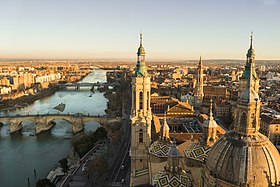 View of Zaragoza and the Ebro | |
.svg.png) Flag  Coat of arms | |
| Nickname(s): | |
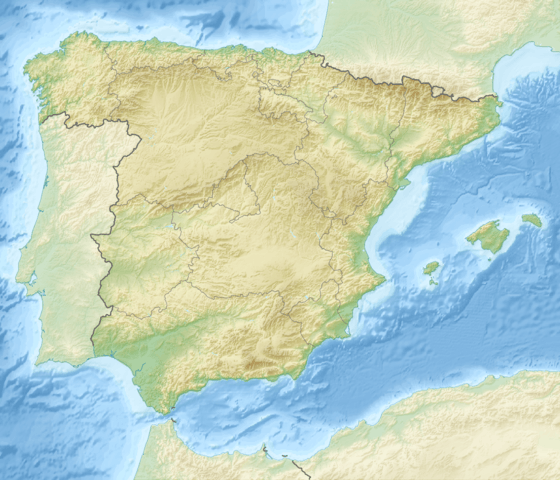 Zaragoza Location of Zaragoza within Aragon  Zaragoza Zaragoza (Aragon)  Zaragoza Zaragoza (Europe) | |
| Coordinates: 41°39′N 0°53′W | |
| Country | |
| Autonomous community | |
| Province | Zaragoza |
| Comarca | Zaragoza |
| Districts | Centro, Casco Histórico, Delicias, Universidad, San José, Las Fuentes, La Almozara, Oliver-Valdefierro, Torrero-La Paz, Actur-Rey Fernando, El Rabal, Casablanca, Santa Isabel, Miralbueno, Sur, Distrito Rural |
| Government | |
| • Type | Mayor–council |
| • Body | Ayuntamiento de Zaragoza |
| • Mayor | Jorge Azcón (People's Party) |
| Area | |
| • Total | 973.78 km2 (375.98 sq mi) |
| Elevation | 243 m (797 ft) |
| Population (2018)[2] | |
| • Total | 666,880 |
| • Density | 680/km2 (1,800/sq mi) |
| Demonym(s) | zaragozano (m), zaragozana (f) |
| Time zone | CET (GMT +1) |
| • Summer (DST) | CEST (GMT +2) |
| Postcode | 50001 – 50020 |
| ISO 3166-2 | ES-Z |
| Website | www |
On 1 January 2019 the population of the city of Zaragoza was 706,904,[5] within its administrative limits on a land area of 1,062.64 square kilometres (410.29 square miles), ranking fifth in Spain. It is the 32nd most populous municipality in the European Union. The population of the metropolitan area was estimated in 2006 at 783,763 inhabitants. The municipality is home to more than 50 percent of the Aragonese population. The city lies at an elevation of 199 metres (653 feet) above sea level.
Zaragoza hosted Expo 2008 in the summer of 2008, a world's fair on water and sustainable development. It was also a candidate for the European Capital of Culture in 2012.
The city is famous for its folklore, local gastronomy, and landmarks such as the Basílica del Pilar, La Seo Cathedral and the Aljafería Palace. Together with La Seo and the Aljafería, several other buildings form part of the Mudéjar Architecture of Aragon which is a UNESCO World Heritage Site. The Fiestas del Pilar are among the most celebrated festivals in Spain.
Etymology
The Romans called the ancient city Caesaraugusta, from which the present name derives. The Iberian town that preceded Roman colonisation was called Salduie.[6]
History
Roman Caesaraugusta
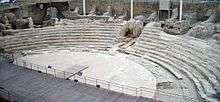
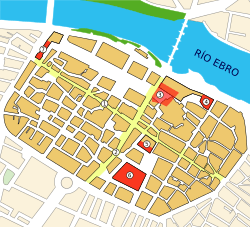
The Sedetani, a tribe of ancient Iberians, populated a village called Salduie (Salduba in Roman sources). Later on, Augustus founded a city called Caesaraugusta[7] at the same location to settle army veterans from the Cantabrian wars. The foundation date of Caesaraugusta has not been set with exact precision, though it is known to lie between 25 BC and 11 BC. The city did not suffer any decline during the last centuries of the Roman empire and was captured peacefully by the Goths in the fifth century AD.

Taifa of Zaragoza
From 1018 to 1118, Zaragoza was one of the taifa kingdoms, independent Muslim states which emerged in the eleventh century following the destruction of the Caliphate of Córdoba. During the first three decades of this period, 1018–1038, the city was ruled by the Banu Tujib. In 1038 they were replaced by the Banu Hud, who had to deal with a complicated alliance with El Cid of Valencia and his Castilian masters against the Almoravids, who managed to bring the Taifas Emirates under their control. After the death of El Cid his kingdom was overrun by the Almoravids, who, by 1100, had managed to cross the Ebro into Barbastro, which brought Aragon into direct contact with them. The Banu Hud stubbornly resisted the Almoravids and ruled until they were eventually defeated by them in May 1110.

Aragonese era
On 18 December 1118, the Aragonese led by Alfonso I conquered the city from the Almoravids,[8] and made it the capital of the Kingdom of Aragon.[9] After Alfonso's death without heirs in 1134, Zaragoza was swiftly occupied by Alfonso VII of León. The city control was held by García Ramírez, king of Navarra, until 1136 when it was given to Ramiro II the Monk in the treaty signed at the betrothal of Ramiro's daughter Petronila and Alfonso's son Sancho. The wedding never happened, as Petronila ended up marrying Ramon Berenguer IV, Count of Barcelona. The marriage union was the origin of the Crown of Aragón, and union with Castile would not happen for another 333 years, when King Ferdinand II of Aragon and his wife, Queen Isabella I of Castile, each took their respective thrones.
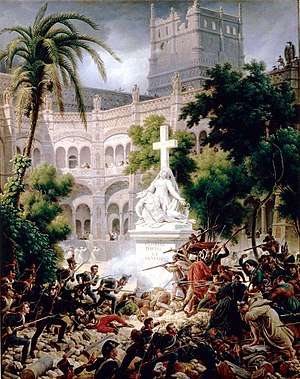
13th century Zaragoza was the scene of two controversial martyrdoms related with the Spanish Inquisition: those of Saint Dominguito del Val, a choirboy in the basilica, and Pedro de Arbués, head official of the inquisition. While the reality of the existence of Saint Dominguito del Val is questioned, his "murder" at the hands of "jealous Jews" was used as an excuse to murder or convert the Jewish population of Zaragoza.[10]
Zaragoza suffered two famous sieges during the Peninsular War against the Napoleonic army: a first from June to August 1808; and a second from December 1808 to February 1809, surrendering only after some 50,000 defenders had died.[11]
Modern history
Despite a decline in the outlying rural economy, Zaragoza has continued to grow. The General Military Academy, a higher training center of the Spanish Army, was re-established on 27 September 1940, by Minister of the Army José Enrique Varela Iglesias. During the second half of the 20th century, Zaragoza's population boomed as a number of factories opened in the region.[12]
In 1979, the Hotel Corona de Aragón fire killed at least 80. The armed Basque nationalist and separatist organization ETA has been blamed, but officially the fire is still regarded as accidental.[13] ETA carried out the Zaragoza barracks bombing in 1987 which killed eleven people, including a number of children, leading to 250,000 people taking part in demonstrations in the city.[14]
Since 1982, the city has been home to a large factory, built by General Motors for the production of Opel cars, some of which are exported to the United Kingdom and sold under the Vauxhall brand.
Demographics
Population, in thousands, can be seen here:
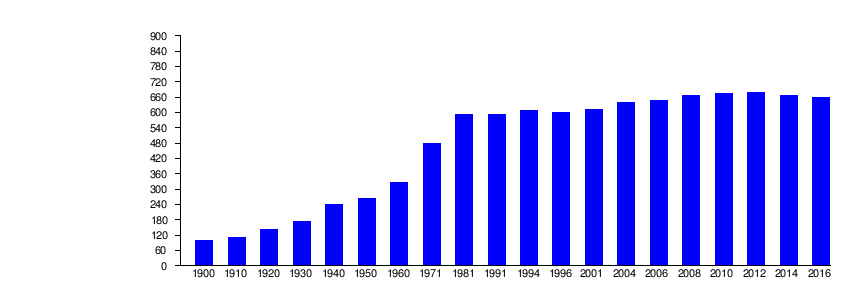
| Year | 1991 | 1996 | 2001 | 2006 | 2011 | 2016 |
|---|---|---|---|---|---|---|
| Population | 594,394 | 601,674 | 610,976 | 649,181 | 674,725 | 661,108 |
- Population data: National Statistics Institute of Spain (INE)
Immigration
In 2017 there were 64,003 foreign citizens in Zaragoza,[16] which represent 9.6% of the total population. From 2010 to 2017 immigration dropped from 87,735 to 64,003 people, a 27% drop. Romanians represent 29.8% of foreigners living in Zaragoza, or 2.9% of the total city population, followed by Moroccans (9.1%) and Chinese (7%).
| Foreign Nationals in Zaragoza in 2017[16] | |||||||
|---|---|---|---|---|---|---|---|
| Position | Nationality | People | |||||
| 1st | 19,064 | ||||||
| 2nd | 5,804 | ||||||
| 3rd | 4,497 | ||||||
| 4th | 3,302 | ||||||
| 5th | 2,488 | ||||||
| 6th | 2,470 | ||||||
| 7th | 2,117 | ||||||
| 8th | 1,115 | ||||||
| 9th | 1,030 | ||||||
Climate
Zaragoza has a cool semi-arid climate (Köppen: BSk),[17] as it lies in a wide basin entirely surrounded by mountains which block off moist air from the Atlantic and Mediterranean. The average annual precipitation is a scanty 322 millimetres (12.7 in) with abundant sunny days, and the most rainy seasons are spring (April–May) and autumn (September–November), with a relative drought in summer (July–August) and winter (December–March).
Temperatures are hot in summer reaching up to 44.5 °C (112.1 °F), and in winter are cool, either because of the fog (about twenty days from November to January ) or a cold and dry wind blowing from the northwest, the Cierzo (related to other northerly winds such as the Mistral in the SE of France) on clear days. Frost is common and there is sporadic snowfall. The Cierzo can cause a 'wind chill factor' as low as −10 °C (14 °F) during cold spells.
| Climate data for Zaragoza Airport, altitude 263m (averages for 1981-2010) | |||||||||||||
|---|---|---|---|---|---|---|---|---|---|---|---|---|---|
| Month | Jan | Feb | Mar | Apr | May | Jun | Jul | Aug | Sep | Oct | Nov | Dec | Year |
| Record high °C (°F) | 20.6 (69.1) |
25.5 (77.9) |
28.3 (82.9) |
32.4 (90.3) |
36.5 (97.7) |
41.0 (105.8) |
44.5 (112.1) |
42.8 (109.0) |
39.2 (102.6) |
32.0 (89.6) |
28.4 (83.1) |
22.0 (71.6) |
44.5 (112.1) |
| Average high °C (°F) | 10.5 (50.9) |
13.1 (55.6) |
17.3 (63.1) |
19.6 (67.3) |
24.1 (75.4) |
29.3 (84.7) |
32.4 (90.3) |
31.7 (89.1) |
27.1 (80.8) |
21.4 (70.5) |
14.8 (58.6) |
10.8 (51.4) |
21.0 (69.8) |
| Daily mean °C (°F) | 6.6 (43.9) |
8.2 (46.8) |
11.6 (52.9) |
13.8 (56.8) |
18.0 (64.4) |
22.6 (72.7) |
25.3 (77.5) |
25.0 (77.0) |
21.2 (70.2) |
16.2 (61.2) |
10.6 (51.1) |
7.0 (44.6) |
15.5 (59.9) |
| Average low °C (°F) | 2.7 (36.9) |
3.3 (37.9) |
5.8 (42.4) |
7.9 (46.2) |
11.8 (53.2) |
15.8 (60.4) |
18.3 (64.9) |
18.3 (64.9) |
15.2 (59.4) |
11.0 (51.8) |
6.3 (43.3) |
3.2 (37.8) |
10.0 (49.9) |
| Record low °C (°F) | −10.4 (13.3) |
−11.4 (11.5) |
−6.3 (20.7) |
−2.4 (27.7) |
0.5 (32.9) |
1.6 (34.9) |
8.0 (46.4) |
8.4 (47.1) |
4.8 (40.6) |
0.6 (33.1) |
−5.6 (21.9) |
−9.5 (14.9) |
−11.4 (11.5) |
| Average precipitation mm (inches) | 21.0 (0.83) |
21.5 (0.85) |
19.1 (0.75) |
39.3 (1.55) |
43.7 (1.72) |
26.4 (1.04) |
17.3 (0.68) |
16.6 (0.65) |
29.5 (1.16) |
36.4 (1.43) |
29.8 (1.17) |
21.4 (0.84) |
322 (12.67) |
| Average precipitation days (≥ 1 mm) | 4.0 | 3.9 | 3.7 | 5.7 | 6.4 | 4.0 | 2.6 | 2.3 | 3.2 | 5.4 | 5.1 | 4.8 | 51.1 |
| Average snowy days | 0.7 | 0.4 | 0.2 | 0.0 | 0.0 | 0.0 | 0.0 | 0.0 | 0.0 | 0.0 | 0.1 | 0.5 | 2.4 |
| Average relative humidity (%) | 75 | 67 | 59 | 57 | 54 | 49 | 47 | 51 | 57 | 67 | 73 | 76 | 61 |
| Mean monthly sunshine hours | 131 | 165 | 217 | 226 | 274 | 307 | 348 | 315 | 243 | 195 | 148 | 124 | 2,693 |
| Source: Agencia Estatal de Meteorología[18] | |||||||||||||
Economy

An Opel factory was opened in 1982 in Figueruelas, a small village nearby. The automotive industry is a main pillar of the regional economy along with Balay, which manufactures household appliances; CAF, which builds railway rolling stock for both the national and international markets; SAICA and Torraspapel in the stationery sector; and various other local companies, such as Pikolin, Lacasa, and Imaginarium SA.
The city's economy benefited from projects like the Expo 2008, the official World's Fair, whose theme was water and sustainable development, held between 14 June and 14 September 2008, Plataforma Logística de Zaragoza (PLAZA), and the Parque Tecnológico de Reciclado (PTR). Furthermore, since December 2003, it has been a city through which the AVE high-speed rail travels. Currently, Zaragoza Airport is a major cargo hub in the Iberian Peninsula, behind only Madrid, Barcelona, and Lisbon.
Zaragoza is home to a Spanish Air Force base, which was shared with the U.S. Air Force until 1994.[19] In English, the base was known as Zaragoza Air Base. The Spanish Air Force maintained a McDonnell Douglas F/A-18 Hornet wing at the base. No American flying wings (with the exception of a few KC-135's) were permanently based there, but it served as a training base for American fighter squadrons across Europe. It also hosts the main Spanish Army academy, Academia General Militar, a number of brigades at San Gregorio, and other garrisons.[20]
Culture
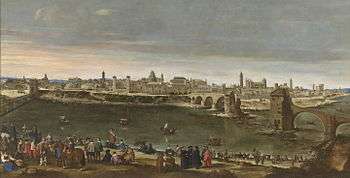
Christianity took root in Zaragoza at an early date.[21] According to legend, St. Mary appeared miraculously to Saint James the Great in Zaragoza in the first century, standing on a pillar. This apparition is commemorated by a famous Catholic basilica called Nuestra Señora del Pilar ("Our Lady of the Pillar").[22]
Festivals

The annual Fiestas del Pilar last for nine days, with its main day on 12 October. Since this date coincided in 1492 with the first sighting by Christopher Columbus of the Americas, that day is also celebrated as El Día de la Hispanidad (Columbus Day) by Spanish-speaking people worldwide.
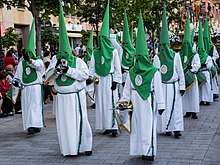
There are many activities during the festival, from the massively attended Pregon (opening speech) to the final fireworks display over the Ebro; they also include marching bands, dances such as "Jota aragonesa" (the most popular dance of folklore music genre), a procession of gigantes y cabezudos, concerts, exhibitions, vaquillas, bullfights, fairground amusements, and fireworks. Some of the most important events are the Ofrenda de Flores, or Flower Offering to St. Mary of the Pillar, on 12 October, when an enormous surface resembling a cloak for St. Mary is covered with flowers, and the Ofrenda de Frutos on 13 October, when all the autonomous communities of Spain offer their typical regional dishes to St. Mary and donate them to soup kitchens.
Holy Week in Zaragoza, although not as elaborate an affair as its Andalusian or Bajo Aragón counterparts, has several processions passing through the city centre every day with dramatic sculptures, black-dressed praying women and hundreds of hooded people playing drums. It has been a Festival of International Tourist Interest since 2014.[23]
Education
The University of Zaragoza is based in the city. As one of the oldest universities in Spain and a major research and development centre, this public university awards all the highest academic degrees in dozens of fields. Zaragoza is also home to the MIT-Zaragoza International Logistics Program, a unique partnership between MIT, the Government of Aragon and the University of Zaragoza.
There is also a private university, Universidad San Jorge, which is located in Villanueva de Gállego.
There is a French international primary and secondary school, Lycée Français Molière de Saragosse.
Transportation
.jpg)
Roads

The city is connected by motorway with the main cities in central and northern Spain, including Madrid, Barcelona, Valencia, and Bilbao, all of which are located about 300 kilometres (200 miles) from Zaragoza.
Buses
The city has a network of buses which is controlled by the Urban Buses of Zaragoza (AUZSA). The network consists of 31 regular lines (two of them circle lines), two scheduled routes, six shuttle buses (one free), and seven night buses operating on Fridays, Saturdays and other festivities.[25] Zaragoza also has an interurban bus network operated by Transport Consortium Zaragoza Area (CTAZ) that operates 17 regular lines.[26]
Bicycle
Zaragoza's bicycle lanes facilitate non-motorized travel and help cyclists to avoid running into pedestrians and motor vehicles. The city council also has a public bicycle-hire scheme; the 'bizi zaragoza' - which consists in the payment of an annual charge.
Tram
The first line of the Zaragoza tram (Valdespartera-Parque Goya) is fully operational.
Railway
Zaragoza is a part of the Spanish high-speed railway operated by RENFE, AVE, which connects Madrid and Barcelona via high-speed rail. Madrid can be reached in 75 minutes, and Barcelona in approximately 90 minutes. The central station is "Intermodal Zaragoza Delicias Station", which serves both railway lines and coaches. In addition to long-distance railway lines and the high-speed trains, Zaragoza has a network of commuter trains operated by RENFE called cercanías.

Airport
Zaragoza Airport is located in the Garrapinillos neighborhood, 10 kilometers from the city center.
It is a major commercial airport, its freight traffic surpassing that of Barcelona El Prat in 2012,[27] and serves as the home of the Spanish Air Force's 15th Group. It was also used by NASA as a contingency landing site for the Space Shuttle in the case of a Transoceanic Abort Landing (TAL).
Public transportation statistics
The average amount of time people spend commuting with public transit in Zaragoza, for example to and from work, on a weekday is 48 min. 9% of public transit riders, ride for more than 2 hours every day. The average amount of time people wait at a stop or station for public transit is 11 min, while 12% of riders wait for over 20 minutes on average every day. The average distance people usually ride in a single trip with public transit is 4.2 km, while 5% travel for over 12 km in a single direction.[28]
Sports
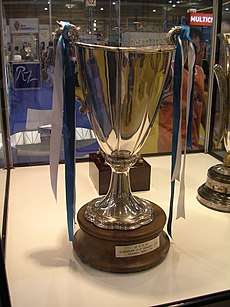

.jpg)
Football
Zaragoza's main football team, Real Zaragoza, plays in the Segunda División. Founded on 18 March 1932, its home games are played at La Romareda, which seats 34,596 spectators. The club has spent the majority of its history in La Liga. One of the most remarkable events in the team's recent history is the winning of the former UEFA Cup Winners' Cup in 1995. The team has also won the Spanish National Cup "Copa del Rey" six times: 1965, 1966, 1986, 1994, 2001 and 2004 and an Inter-Cities Fairs Cup (1964). A government survey in 2007 found that 2.7% of the Spanish population support the club, making them the seventh-most supported in the country.
Zaragoza's second football team is CD Ebro. Founded in 1942, it plays in Segunda División B – Group 2, holding home games at Campo Municipal de Fútbol La Almozara, which has a capacity of 1,000 seats.
Zaragoza CFF is a Spanish women's football team from Zaragoza playing in Primera División Femenina.
Zaragoza was one of the Spanish cities which hosted the FIFA World Cup 1982. Three matches were played at La Romareda.
Basketball
The main basketball team, Basket Zaragoza, known as Tecnyconta Zaragoza for sponsorship reasons, plays in the Liga ACB. They play their home games at the Pabellón Principe Felipe with a capacity of 10,744.
Stadium Casablanca, a.k.a. Mann Filter for sponsorship reasons, is the Spanish women's basketball club from Zaragoza that plays in the Primera Division.
Futsal
The main futsal team, is Dlink Zaragoza, plays in the LNFS Primera División. They play at the Pabellón Siglo XXI with a capacity of 2,600.
Other Sports
Zaragoza's handball team, BM Aragón, plays in the Liga ASOBAL.
The Spanish Baja or Baja Aragon is a Rally raid event held in the region of Aragon in northern Spain. This event was launched in 1983, and chose the desert of Monegros because of the scenery and availability of service infrastructure in Zaragoza.
Zaragoza was strongly associated with Jaca in its failed bid for the 2014 Winter Olympics.
There are three Rugby Union teams playing in the regional league:
- Ibero Club de Rugby Zaragoza
- Fénix Club de Rugby
- Club Deportivo Universitario de Rugby
A permanent feature built for Expo 2008 is the pump-powered artificial whitewater course "El Canal de Aguas Bravas."
Main sights

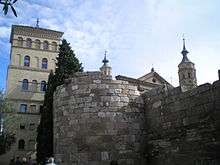

Near the basilica on the banks of the Ebro are located the city hall, the Lonja (old currency exchange), La Seo (literally "the See" in the Aragonese language) or Cathedral of San Salvador, a church built over the main mosque (partially preserved in the 11th-century north wall of the Parroquieta), with Romanesque apses from the 12th century; inside, the imposing hallenkirche from the 15th to 16th centuries, the Baroque tower, and finally, with its famous Museum of Tapestries near the Roman ruins of forum and port city wall.
Some distance from the centre of the old city is the Moorish castle (or palace) Aljafería, the most important Moorish buildings in northern Spain and the setting for Giuseppe Verdi's opera Il trovatore (The Troubadour). The Aragonese parliament currently sits in the building.
The churches of San Pablo, Santa María Magdalena and San Gil Abad were built in the 14th century, but the towers may be old minarets dating from the 11th century; San Miguel (14th century); Santiago (San Ildefonso) and the Fecetas monastery are Baroque with Mudéjar ceilings of the 17th century. All the churches are Mudéjar monuments that comprise a World Heritage Site.[29]
Other important sights are the stately houses and palaces in the city, mainly of the 16th century: palaces of the count of Morata or Luna (Audiencia), Deán, Torrero (colegio de Arquitectos), Don Lope or Real Maestranza, count of Sástago, count of Argillo (today the Pablo Gargallo museum), archbishop, etc.
On 14 June 2008, the site of Expo 2008 opened its doors to the public. The exhibition ran until 14 September.
Other sights

- Puente de Piedra
- San Ildefonso church
- Santa Engracia Monastery
- Fuente de la Hispanidad
Museums[30] in Zaragoza are:
- Museum of Fine Arts Zaragoza, with paintings by early Aragonese artists, 15th century, and by El Greco, Ribera and Goya, and the Camón Aznar Museum, with paintings ranging from Rubens, Rembrandt, Van Dyck, Velazquez and Goya to Renoir, Manet and Sorolla.[31]
Twin towns and sister cities
Zaragoza is twinned with:[32][33]
|
Zaragoza has special bilateral collaboration agreements with:
Notable people
- Avempace (1085–1138), polymath
- Sebastián Pozas (1876–1946), military officer
- Abraham Abulafia (1240–1291), founder of the school of "Prophetic Kabbalah"
- Amaral (band) (1992–present), popular musical band in Spain and America.
Notes
- English pronunciation: /ˌzærəˈɡoʊzə, ˌsærəˈɡoʊsə, ˌθærəˈɡoʊθə/; Spanish pronunciation: [θaɾaˈɣoθa]
- English pronunciation: /ˌsærəˈɡɒsə/[3]
References
- Martí Font, J.M. (2017). La España de las ciudades: El Estado frente a la sociedad urbana (in Spanish). ED Libros. ISBN 9788461799220.
- Municipal Register of Spain 2018. National Statistics Institute.
- "Saragossa". Collins Dictionary. n.d. Archived from the original on 23 September 2015. Retrieved 26 September 2014.
- Encyclopædia Britannica Zaragoza (conventional Saragossa) Archived 2012-03-07 at the Wayback Machine
- Gomar, Carlota (9 January 2019). "Zaragoza vuelve a crecer y supera la barrera de los 700.000 habitantes". El Periódico de Aragón (in Spanish).
- Alex Mullen; Patrick James (6 September 2012). Multilingualism in the Graeco-Roman Worlds. Cambridge University Press. p. 104. ISBN 978-1-139-56062-7.
- Sivan, H., S. Keay, R. Mathisen, DARMC, R. Talbert, S. Gillies, J. Åhlfeldt, J. Becker, T. Elliott. "Places: 246344 (Col. Caesaraugusta)". Pleiades. Archived from the original on 24 December 2014. Retrieved 23 December 2014.CS1 maint: multiple names: authors list (link)
- Rogers, Clifford J., ed. (2010). The Oxford Encyclopedia of Medieval Warfare and Military Technology. 1. Oxford: Oxford University Press. p. 466. ISBN 978-0-19-533403-6. Archived from the original on 2017-03-19.
- "Aragon | region, Spain". Encyclopedia Britannica. Archived from the original on 2017-08-25. Retrieved 2017-08-25.
- "Jewish Community of Zaragoza". Aragonguide.com. Archived from the original on 2011-07-07. Retrieved 2011-04-10.
- "Napoleon's Total War". Historynet.com. 7 March 2007. Archived from the original on 19 March 2017. Retrieved 2017-03-16.
- Marina Van Geenhuizen; Peter Nijkamp (1 April 2012). Creative Knowledge Cities: Myths, Visions and Realities. Edward Elgar Publishing. p. 58. ISBN 978-0-85793-285-3. Archived from the original on 2 May 2018.
- "El incendio del Corona de Aragón, fue provocado, según "El Alcázar"". El País (in Spanish). PRISA. 20 November 1979. Archived from the original on 15 March 2016. Retrieved 25 July 2016.
.
- Reuters (1987-12-12). "11 Killed by Bomb in Northern Spain". The New York Times. ISSN 0362-4331. Archived from the original on 2018-02-01. Retrieved 2018-02-01.
- "Postelectoral Elecciones Autonómicas y Municipales 2019. Zaragoza (Municipio de); Results on page 47" (PDF). 2019. Retrieved 2020-05-14.
- "Población por sexo, municipios y nacionalidad (principales nacionalidades) - Zaragoza". Instituto Nacional de Estadística (in Spanish). Retrieved 12 July 2018.
- "Zaragoza, Spain Köppen Climate Classification (Weatherbase)". Weatherbase. Archived from the original on 2 May 2018. Retrieved 13 March 2018.
- "Standard Climate Values. Zaragoza Aeropuerto". Archived from the original on 2015-07-07. Retrieved 1 July 2019.
- John Pike. "Zaragoza Air Base". Globalsecurity.org. Archived from the original on 2009-06-17. Retrieved 2009-06-25.
- "Spanish Army units at Zaragoza". Spanish MoD. Retrieved 8 October 2018.
- Albert Frederick Calvert (1908). Valladolid, Oviedo, Segovia, Zamora, Avil, & Zaragoza: An Historical & Descriptive Account. Lane. p. 136.
- J. Gordon Melton (15 January 2014). Faiths Across Time: 5,000 Years of Religious History. ABC-CLIO. p. 734. ISBN 978-1-61069-026-3.
- "Archived copy" (PDF). Archived (PDF) from the original on 2016-03-04. Retrieved 2018-01-07.CS1 maint: archived copy as title (link)
- "Puente del Tercer Milenio – Third Millennium Bridge". Discover Monuments, Zaragoza. Sociedad Estatal para la Gestión de la Innovación y las Tecnologías Turísticas, S.A. (SEGITTUR). Archived from the original on 20 June 2013. Retrieved 27 December 2012.
- "Avanza Zaragoza". www.urbanosdezaragoza.es. Archived from the original on 4 June 2017. Retrieved 13 March 2018.
- "portada - consorciozaragoza.es". www.consorciozaragoza.es. Archived from the original on 13 March 2018. Retrieved 13 March 2018.
- J. L. Gaona (13 September 2012). "El aeropuerto de Zaragoza supera al de Barcelona en tráfico de mercancías". Heraldo. Zaragoza: Heraldo de Aragon Editora Digital. Tráfico aéreo. Archived from the original on 3 November 2012. Retrieved 30 June 2014.
- "Zaragoza Public Transportation Statistics". Global Public Transit Index by Moovit. Archived from the original on 24 August 2017. Retrieved 19 June 2017.

- Centre, UNESCO World Heritage. "Mudejar Architecture of Aragon". whc.unesco.org. Archived from the original on 2017-10-03. Retrieved 2017-08-24.
- "Municipal Museums and Exhibitions". www.zaragoza.es. Archived from the original on 13 March 2018. Retrieved 13 March 2018.
- www.area25.es, Area25 IT -. "Provincial Museum of Fine Arts". InSpain. Archived from the original on 13 March 2018. Retrieved 13 March 2018.
- "Zaragoza Internacional: Hermanamientos con Zaragoza" (official website) (in Spanish). Ayuntamiento de Zaragoza. Retrieved 8 October 2018.
- "International Zaragoza: Town Twinnings" (official website). Zaragoza Council. Retrieved 8 October 2018.
Bibliography
External links
| Wikimedia Commons has media related to Zaragoza. |
| Wikivoyage has a travel guide for Zaragoza. |
- Council of Zaragoza
- Zaragoza Tourism Board Official Website
- Demographics in 2015: Zaragoza City council